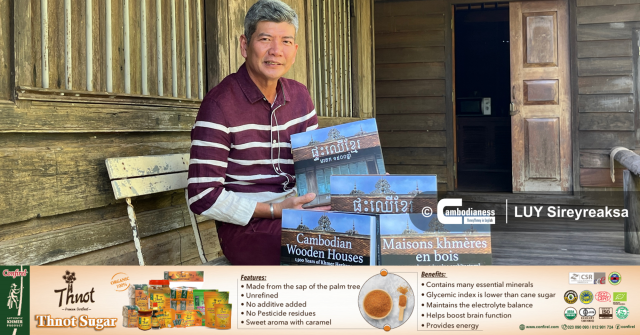Shading Light on Khmer Wooden Houses of the Last 1,500 Years

- By Zul Rorvy
- December 10, 2023 2:10 PM
SIEM REAP—For more than 20 years, Hok Sokol and his co-author Darryl Collins have conducted research on Cambodian traditional wooden houses. Their years of travels across the country enabled them to compile several books on Khmer architecture with the most recent one entitled "Cambodian Wooden Houses: 1,500 Years of Khmer Heritage" released in 2022.
With the book now available in three languages—English, Khmer and French—Sokol, amidst today’s world, aims to keep alive and thriving the memory and the physicality of Cambodian wooden houses that are adapted to the country’s climate and conditions, as he explained during an interview.
Zul Rorvy: First, why did you first publish your book in English rather than in Khmer?
Hok Sokol: As of now, this is already the second edition of our English version. Our first edition was published at the beginning of 2022. In this new version, we have modified some sections that needed to be corrected as well as added new contents. After we had completed this second edition in English, we worked on translating it into Khmer and French languages.
So, why did we decide to make it first in English? My co-author, Darryl Collin, was an Australian. During the making of the first edition, his health was already deteriorating. To speed things up, we tried to do what we could and that was to publish the book in English first. Unfortunately, he did not live long enough to see the Khmer and French versions of his book.
Zul Rorvy: As background for our readers, why did you decide to write this book?
Hok Sokol: This is a rather long story to say the least. It began more than 20 years ago when I was writing my thesis on the topic of Khmer houses in relation to the tourism sector. This thesis required me to study “Khmer habitations and tourism” in many parts of Cambodia.
An opportunity I got was to work with my former professor [art historian] Darryl Collin. So, in 2006, we wrote the book entitled “Building Cambodia: New Khmer Architecture 1953 – 1970” [with architect Helen Grant]. That same year, we started envisioning another book on Khmer wooden houses.
In 2006, Darryl Collin moved from Phnom Penh to Siem Reap in an old Khmer traditional wooden house that was purchased in Hanchey village in Kampong Cham province. Once the previous owner had sold it, we disassembled the house before reassembling it in Siem Reap. When he was in Siem Reap, the two of us could meet more easily to devise plans for our book.

Zul Rorvy: Was it challenging to compile such a long and information book?
Hok Sokol: I can say that this is not an easy task. You cannot plough the entire field in one day. You have to start and work with capacity you have. An extensive amount of research and evidence has to be gathered before starting to write such a book. We spent years finding information in the field. At the same time, I also spent my days working on different architecture projects, and met many people in many related fields who offered me insights into the technical and religious aspects of Khmer vernacular houses.
It was only in 2015 that we thought we had gathered enough information for the book. We came up with nine chapters in total. We shared the work, each one writing four chapters with one chapter, the 9th one, being a combined effort.
Zul Rorvy: So, you went to almost every province to learn about the Khmer wooden houses?
Hok Sokol: Yes, I did travel to almost every province of Cambodia. However, I mainly focused on Khmer wooden houses that had more potential. We also travelled to Mondulkiri province in the northeastern part of Cambodia to study the wooden houses of the indigenous population. Since we thought we still lacked information in this area of research, we did not include it in our book. The wooden houses that I mainly focus on are from provinces that are well-connected to rivers and streams such as Kratie, Kampong Cham, Siem Reap, Battambang, Kandal, Prey Veng and Kampong Thom. They are rich in history when observed within the scope of the last century.
In addition, we delved deeper into the geography of Cambodia with its tropical terrain rich in precious woods. We also looked into the commercial use of wood resources during the French colonial era and the uses of wood in old architecture in ancient times as far back as 1,500 years ago.
_1689743075_1702184885.jpg)
Zul Rorvy: In your expert eye, do houses look different in the various provinces?
Hok Sokol: Yes, they are different. Houses are made to serve the needs of the residents. People from Kampong Cham will live somewhat differently from people in Siem Reap. In Kampong Cham province, villagers focus more on commercial activities related to the Mekong river, traditional medicines, corn, beans, sesame or tobacco. In Siem Reap and Battambang provinces, people focus more on rice production. These commercial aspects make people live the way they do.
Moving southward along the river, people in Kratie or Kandal provinces often trade with Vietnam and China as they live relatively close to the sea. Therefore, I noticed that some construction materials, such as column footings, were even transported from China.
Back to Battambang, since the province was under Thai administration for a period of time in the past, there were more or less some architectural influences from Thailand. Regardless, Battambang province does have its own unique architecture. A blend between older and newer Khmer style, Thai style, European style and most recently French style.
_1689743058_1702184903.jpg)
Zul Rorvy: In chapter 8, you compare the wooden houses to something pretty much alive. You call it “living houses.” Why is that?
Hok Sokol: For older generations, houses have sentimental values. The tie between them and their house can be strongly felt. It seems that the house is alive. For example, when a previous owner does not have the capability to look after that house, the house will seek new owners. This seems like houses “walk” to find new people to take care of them. That is the meaning of the idea.
For the past two decades or so, I have just wanted to share my findings with the Cambodian people on Khmer traditional wooden houses. I want to show what the ideal and down-to-earth Khmer wooden houses look like, function and behave. Of course, we could not focus on the enormously large luxurious wooden houses built to project power by wealthy individuals. We shed lights on houses with history and practicality, not houses built for the sole objective of being an ornament. Houses will lose their soul when people stop using them.

Zul Rorvy: Where can readers find your books?
Hok Sokol: Our book, in three languages, will be available in major book centres, some coffee shops and some high-end hotels. Plus, we are preparing to open our own gallery to showcase and put on sales our products. Moreover, during the upcoming National Book Fair on Koh Pich island in Phnom Penh held from Dec. 14 to 18, we will showcase our books at the event.
Written in Khmer for ThmeyThmey News, the story was translated by Ky Chamna for Cambodianess.
Related articles:
The New Life of a Century-Old Khmer Wooden House in Siem Reap
Khmer Wooden Houses: Modernise, but Don’t Forget to Preserve


















